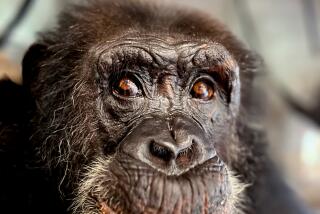Tons of Beauty : L.A. Zoo Keepers Primp and Pamper Their Pachyderms
- Share via
How do you trim the toenails of a five-ton elephant?
If this was a corny elephant joke, the punch line would be: “Very, very carefully.”
But to the four keepers who work with the Los Angeles Zoo’s small herd, elephants are nothing to joke about, and the handlers are very careful when they are with the huge animals, especially during the pachyderms’ pedicures, baths and skin moisturizing.
Pedicures? Skin moisturizing?
Such pampering has an important purpose, keeper Jeff Briscoe said.
Experience has shown that pampering is vital for creatures as intelligent, sensitive and potentially dangerous as elephants, Briscoe explained. Animals that get a lot of firm but affectionate attention are better behaved, easier to work with and much safer to be around.
So every morning, one of the zoo’s two-member teams of elephant keepers spend the first 90 minutes of the day grooming the animals for the zoo’s 10 a.m. opening.
Because the work is difficult, demanding and occasionally dangerous, Briscoe and the other keepers--Gene Nada, Marilyn Fackler-Gray and George French--are volunteers, and the elephants are chained--one foreleg, one back leg.
“Any animal that weighs 10,000 pounds is dangerous,” Briscoe said, “even if it doesn’t want to be.”
While the keepers clean up the barns, the elephants slurp up 20 to 40 gallons of water and munch on carrots, onions and a dry snack called monkey biscuits. (The elephants’ main meal of oats and hay is eaten at night.)
Then the pampering begins.
While a pedicure for an elephant might seem excessive, Briscoe said it is a necessity for zoo elephants because they do not walk as much as as their wild relatives, who may cover more than 20 miles a day foraging for food.
Also, contrary to what one might think, Briscoe said, elephants walk on their tiptoes, which makes their big toenails quite vulnerable to tearing and cracking.
Confined elephants must have their toenails and cuticles oiled, softened, shaped and smoothed because cracks and rough edges can be as painful as a human’s hangnail. They also can cause serious health hazards to the valuable animals.
The keepers use carpenter’s drawknives, farrier’s hoof-picks and long metal rasps to minister to the animals, who are trained to lift their feet onto a special stand for the pedicures. The older elephants require nail-trimming at least once a week.
Another essential in elephant care is the daily bath and skin moisturizing.
The bath is a must, Briscoe said, because elephants habitually toss dust, dirt and hay on their backs, and they can get pretty gritty and grimy.
In the wild, Briscoe said, this behavior is a protective measure--dirt and grass provides insulation against heat and protection from insects.
Briscoe said elephants’ thick skin is both exceptionally tough and exceptionally sensitive, prone not only to bothersome insect bites, but also to sunburn, drying, flaking, cracking and scrapes.
The preferred method of bathing elephants is with water; they are squirted with hoses and scrubbed down with stiff brushes. But if the weather is chilly, as it was one morning recently when two guests were permitted to watch the routine, the elephants are given “dry baths” with brushes because, like humans, they are susceptible to colds.
“I wish it wasn’t so chilly today,” Briscoe said, “because they look so nice after we’ve just washed them all over. When they go out, I stop for a moment and just look at them, all scrubbed up, and they’re just beautiful.”
The elephants’ feet and legs were sprayed with water, but none was completely wetted down.
Gita and Tara--”the girls” as Briscoe calls them--responded quickly to verbal orders to lie down for their brushing, but 8-year-old Hannibal--”the kid” to the keeper--had to be addressed with considerable volume and firmness before he obeyed the command “Down!”
Both of the females made croaking sounds as their backs were being brushed--a sure sign they were enjoying the sprucing up, Briscoe said.
Sometimes, when the elephants are particularly relaxed and contented, they make deep purring sounds, he said.
After the brushing, Briscoe turned to the two African elephants, Tara, 26, and Hannibal for a bit of tusk polishing with steel wool and scouring powder.
“It’s mainly cosmetic, so their ivory looks good,” he said. “They are very proud of their ivory.” Gita, 30, the 10,000-pounder, and Joyce, 16, a slinky 7,800 pounds, are Indian elephants and do not have tusks, but do not seem to care.
However, Joyce, like many teen-agers, has some behavior problems--she doesn’t get along well with the others. She is housed in the zoo’s second barn, spends her nights alone and is groomed separately. By day, she shares a second display yard with Hannibal but is separated from him by a heavy steel gate.
The final grooming touch before the elephants go outside is the skin treatment.
No Longer Oiled
Briscoe said that at one time captive elephants were regularly oiled over their whole bodies, but that is no longer done at the Los Angeles Zoo because it was learned that the oil plugged up skin pores.
Now, he said, a moisturizing oil called neatsfoot is applied with a paintbrush mainly to scrapes and and wear points, such as the “elbows,” the feet and around the eyes, where it looks almost like dark mascara.
Just after 10 a.m., with all the washing, trimming and primping done, the pampered pachyderms tip-toed gracefully outside to show themselves off to the waiting public.
They looked just beautiful.






